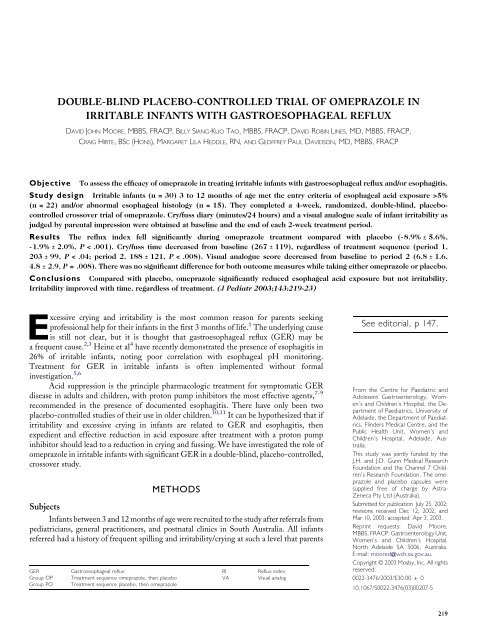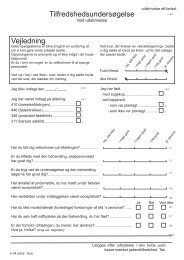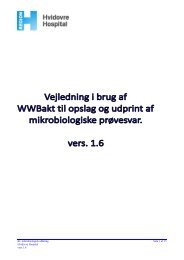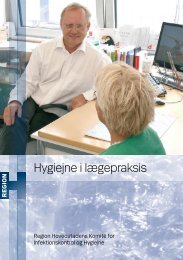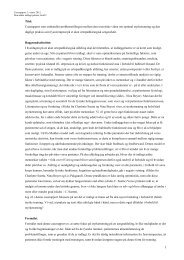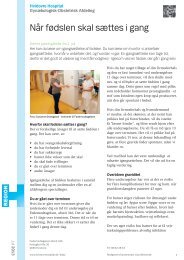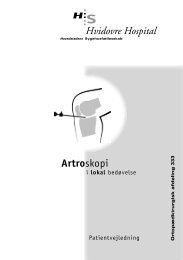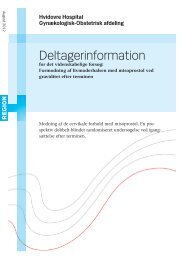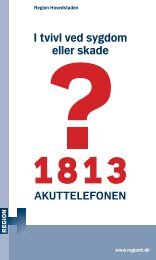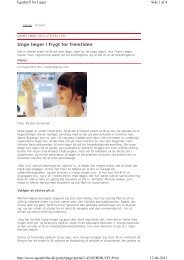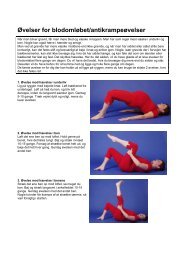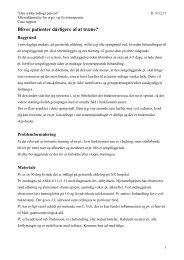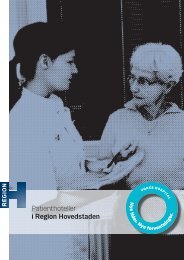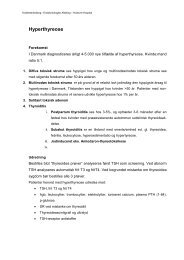double-blind placebo-controlled trial of omeprazole
double-blind placebo-controlled trial of omeprazole
double-blind placebo-controlled trial of omeprazole
You also want an ePaper? Increase the reach of your titles
YUMPU automatically turns print PDFs into web optimized ePapers that Google loves.
DOUBLE-BLIND PLACEBO-CONTROLLED TRIAL OF OMEPRAZOLE IN<br />
IRRITABLE INFANTS WITH GASTROESOPHAGEAL REFLUX<br />
DAVID JOHN MOORE,MBBS,FRACP,BILLY SIANG-KUO TAO,MBBS,FRACP,DAVID ROBIN LINES,MD,MBBS,FRACP,<br />
CRAIG HIRTE,BSC (HONS), MARGARET LILA HEDDLE,RN,AND GEOFFREY PAUL DAVIDSON,MD,MBBS,FRACP<br />
Objective To assess the efficacy <strong>of</strong> <strong>omeprazole</strong> in treating irritable infants with gastroesophageal reflux and/or esophagitis.<br />
Study design Irritable infants (n = 30) 3 to 12 months <strong>of</strong> age met the entry criteria <strong>of</strong> esophageal acid exposure >5%<br />
(n = 22) and/or abnormal esophageal histology (n = 15). They completed a 4-week, randomized, <strong>double</strong>-<strong>blind</strong>, <strong>placebo</strong><strong>controlled</strong><br />
crossover <strong>trial</strong> <strong>of</strong> <strong>omeprazole</strong>. Cry/fuss diary (minutes/24 hours) and a visual analogue scale <strong>of</strong> infant irritability as<br />
judged by parental impression were obtained at baseline and the end <strong>of</strong> each 2-week treatment period.<br />
Results The reflux index fell significantly during <strong>omeprazole</strong> treatment compared with <strong>placebo</strong> (-8.9% ± 5.6%,<br />
-1.9% ± 2.0%, P < .001). Cry/fuss time decreased from baseline (267 ± 119), regardless <strong>of</strong> treatment sequence (period 1,<br />
203 ± 99, P < .04; period 2, 188 ± 121, P < .008). Visual analogue score decreased from baseline to period 2 (6.8 ± 1.6,<br />
4.8 ± 2.9, P = .008). There was no significant difference for both outcome measures while taking either <strong>omeprazole</strong> or <strong>placebo</strong>.<br />
Conclusions Compared with <strong>placebo</strong>, <strong>omeprazole</strong> significantly reduced esophageal acid exposure but not irritability.<br />
Irritability improved with time, regardless <strong>of</strong> treatment. (J Pediatr 2003;143:219-23)<br />
Excessive crying and irritability is the most common reason for parents seeking<br />
pr<strong>of</strong>essional help for their infants in the first 3 months <strong>of</strong> life. 1 The underlying cause<br />
is still not clear, but it is thought that gastroesophageal reflux (GER) may be<br />
a frequent cause. 2,3 Heine et al 4 have recently demonstrated the presence <strong>of</strong> esophagitis in<br />
26% <strong>of</strong> irritable infants, noting poor correlation with esophageal pH monitoring.<br />
Treatment for GER in irritable infants is <strong>of</strong>ten implemented without formal<br />
investigation. 5,6<br />
Acid suppression is the principle pharmacologic treatment for symptomatic GER<br />
disease in adults and children, with proton pump inhibitors the most effective agents, 7-9<br />
recommended in the presence <strong>of</strong> documented esophagitis. There have only been two<br />
<strong>placebo</strong>-<strong>controlled</strong> studies <strong>of</strong> their use in older children. 10,11 It can be hypothesized that if<br />
irritability and excessive crying in infants are related to GER and esophagitis, then<br />
expedient and effective reduction in acid exposure after treatment with a proton pump<br />
inhibitor should lead to a reduction in crying and fussing. We have investigated the role <strong>of</strong><br />
<strong>omeprazole</strong> in irritable infants with significant GER in a <strong>double</strong>-<strong>blind</strong>, <strong>placebo</strong>-<strong>controlled</strong>,<br />
crossover study.<br />
METHODS<br />
Subjects<br />
Infants between 3 and 12 months <strong>of</strong> age were recruited to the study after referrals from<br />
pediatricians, general practitioners, and postnatal clinics in South Australia. All infants<br />
referred had a history <strong>of</strong> frequent spilling and irritability/crying at such a level that parents<br />
GER Gastroesophageal reflux RI Reflux index<br />
Group OP Treatment sequence <strong>omeprazole</strong>, then <strong>placebo</strong> VA Visual analog<br />
Group PO Treatment sequence <strong>placebo</strong>, then <strong>omeprazole</strong><br />
See editorial, p 147.<br />
From the Centre for Paediatric and<br />
Adolesent Gastroenterology, Women’s<br />
and Children’s Hospital, the Department<br />
<strong>of</strong> Paediatrics, University <strong>of</strong><br />
Adelaide, the Department <strong>of</strong> Paediatrics,<br />
Flinders Medical Centre, and the<br />
Public Health Unit, Women’s and<br />
Children’s Hospital, Adelaide, Australia.<br />
This study was jointly funded by the<br />
J.H. and J.D. Gunn Medical Research<br />
Foundation and the Channel 7 Children’s<br />
Research Foundation. The <strong>omeprazole</strong><br />
and <strong>placebo</strong> capsules were<br />
supplied free <strong>of</strong> charge by Astra-<br />
Zeneca Pty Ltd (Australia).<br />
Submitted for publication July 25, 2002;<br />
revisions received Dec 12, 2002, and<br />
Mar 10, 2003; accepted Apr 3, 2003.<br />
Reprint requests: David Moore,<br />
MBBS, FRACP, Gastroenterology Unit,<br />
Women’s and Children’s Hospital,<br />
North Adelaide SA 5006, Australia.<br />
E-mail: moored@wch.sa.gov.au.<br />
Copyright Ó 2003 Mosby, Inc. All rights<br />
reserved.<br />
0022-3476/2003/$30.00 + 0<br />
10.1067/S0022-3476(03)00207-5<br />
219
had sought help. Parents had received advice on the nonpharmacologic<br />
management <strong>of</strong> GER, and all infants had been<br />
given pharmacologic treatment for GER. No objective crying<br />
and/or fussing criteria were used as a precondition to<br />
enrollment. At entry, no infant had been investigated for<br />
GER, and all were thriving. Those with a medical or surgical<br />
condition other than GER were excluded from the study.<br />
Approval for the study was obtained from the research ethics<br />
committees <strong>of</strong> the Women’s and Children’s Hospital, Flinders<br />
Medical Centre, and Child and Youth Health <strong>of</strong> South<br />
Australia (an organization overseeing community child health<br />
in the state). Informed consent was obtained from one or both<br />
parents <strong>of</strong> each infant.<br />
Study Design<br />
All subjects underwent upper gastrointestinal endoscopy<br />
under general anesthesia, with a biopsy specimen taken from<br />
the lower esophagus 2 to 3 cm above the lower esophageal<br />
sphincter, followed by 24-hour lower esophageal pH monitoring.<br />
A calibrated antimony pediatric pH probe (Zinetics,<br />
Medtronic Functional Diagnostics, Inc, Salt Lake City, Utah)<br />
was inserted through the nose and positioned above the lower<br />
esophageal sphincter by the Strobel method. 12 Continuous<br />
intra-esophageal pH recordings were recorded for a minimum<br />
<strong>of</strong> 21 hours. The output from the pH probe was recorded into<br />
either an IBM-PC computer (92 studies) or a Synectics<br />
Digitrapper (2 studies) (Medtronic Functional Diagnostics,<br />
Inc). The settings for the IBM program were identical to the<br />
Digitrapper criteria.<br />
Significant GER for entry into the study was defined<br />
as either a reflux index (percentage <strong>of</strong> total recording time pH<br />
5%, or endoscopic biopsy evidence <strong>of</strong> esophagitis.<br />
The biopsy criteria for esophagitis were intra-epithelial<br />
eosinophils 13 or any two <strong>of</strong> the following criteria: basal cell<br />
layer thickness <strong>of</strong> >20% <strong>of</strong> total epithelial thickness, papillary<br />
length >60% <strong>of</strong> the total epithelial thickness, and >20<br />
lymphocytes in at least one high-power field. 14,15<br />
Infants who met the entry criteria commenced a randomized,<br />
<strong>double</strong>-<strong>blind</strong>, <strong>placebo</strong>-<strong>controlled</strong> cross-over <strong>trial</strong> <strong>of</strong><br />
<strong>omeprazole</strong> (infants from 5 to 10 kg were given 10 mg daily<br />
and >10 kg were given 10 mg twice daily) for 2 weeks and an<br />
identical appearing <strong>placebo</strong> (supplied by AstraZeneca) for 2<br />
weeks (periods 1 and 2). The <strong>omeprazole</strong> and <strong>placebo</strong> were<br />
presented in a capsule as microspheres. The contents <strong>of</strong> each<br />
capsule was emptied into a teaspoon <strong>of</strong> applesauce and administered<br />
to the infant. A second 24-hour lower esophageal<br />
pH recording was performed on all subjects at the end <strong>of</strong><br />
period 1. The patient code indicating the order <strong>of</strong> treatment<br />
was broken at the completion <strong>of</strong> the study.<br />
Parents reported infant behavior while on treatment in<br />
two ways. The first was a diary as described by Barr et al, 16 in<br />
which parents recorded infant behavior including crying and<br />
fussing time over a period <strong>of</strong> 24 hours. The diary was kept for<br />
a minimum <strong>of</strong> 5 days at baseline and during the second week <strong>of</strong><br />
each treatment period. The second was a visual analogue (VA)<br />
score (ranging from 0 to 10) <strong>of</strong> parental impression <strong>of</strong> the<br />
overall intensity <strong>of</strong> infant irritability at baseline and during<br />
each treatment period. The scale ranged in severity from no<br />
irritability (0) to the worst imaginable level <strong>of</strong> irritability (10).<br />
A simple device was used, configured as a <strong>double</strong>-sided slide<br />
rule with the side facing the parent showing two extremes <strong>of</strong><br />
‘‘no irritability’’ and ‘‘worst irritability’’ and the side facing the<br />
investigator showing a linear scale <strong>of</strong> 0 to 10. By moving<br />
a cursor between the two extremes, the parent indicated the<br />
level <strong>of</strong> irritability <strong>of</strong> the infant while the investigator read the<br />
score from the back <strong>of</strong> the slide rule.<br />
Data Analysis<br />
A sample size <strong>of</strong> 20 infants would detect an improvement<br />
in cry/fuss time between <strong>omeprazole</strong> and <strong>placebo</strong> <strong>of</strong> 50%, with<br />
a 2-sided significance level (a) <strong>of</strong> .05 and a power (1-b) <strong>of</strong> 80%.<br />
The combined cry/fuss diary and visually assessed irritability<br />
data were analyzed between (a) treatment groups (<strong>omeprazole</strong><br />
and <strong>placebo</strong>), and (b) treatment periods (1 and 2, 2 weeks<br />
each). All data were expressed as mean ± SD. The Mann-<br />
Whitney U test was used to compare distribution <strong>of</strong> variables.<br />
Subjects<br />
RESULTS<br />
Infants (n = 64) between 3 and 12 months <strong>of</strong> age were<br />
recruited and investigated. Infants had all been given empirical<br />
pharmacologic treatment for GER and irritability, which<br />
included cisapride 87%, H2 receptor antagonist 73%, antacid<br />
67%, and thickening agent 20%. None <strong>of</strong> the infants had been<br />
given an empirical <strong>trial</strong> <strong>of</strong> proton pump inhibitor before to<br />
recruitment. No infant had a history <strong>of</strong> hematemesis or<br />
melena. Thirty-four infants met the entry criteria for the<br />
therapeutic <strong>trial</strong>. Four were withdrawn from the study by their<br />
parents during the first 2-week treatment period because <strong>of</strong><br />
persistent crying, leaving 30 infants (median age at endoscopy<br />
4.8 months, range 3-10.2 months, mean age 5.4 ± 2.1 months,<br />
boys 23, girls 7) who completed the study. None <strong>of</strong> the 64<br />
infants had endoscopic changes <strong>of</strong> erosive or ulcerative<br />
esophagitis; 29 infants had normal endoscopic findings in<br />
the distal esophagus, whereas 35 infants demonstrated loss <strong>of</strong><br />
vascular pattern and/or an increase in friability after biopsy.<br />
Fifteen met the endoscopic biopsy criteria, 22 satisfied the<br />
esophageal acid exposure criteria, and 7 met both criteria.<br />
Endoscopic biopsy findings were poorly correlated to pH<br />
findings with increasing acid exposure not significantly related<br />
to esophageal histologic changes (Table I). Eleven infants had<br />
a reflux index >10%. There were no reports <strong>of</strong> adverse events<br />
from treatment with <strong>omeprazole</strong> or <strong>placebo</strong>.<br />
At the completion <strong>of</strong> the study, the randomization code<br />
was broken, and it was found that 15 infants had commenced<br />
treatment with <strong>omeprazole</strong> (group OP) and 15 with <strong>placebo</strong><br />
(group PO).<br />
Reflux Index<br />
There was a significant fall in reflux index from baseline<br />
to the end <strong>of</strong> period 1 in the infants taking <strong>omeprazole</strong><br />
220 Moore et al The Journal <strong>of</strong> Pediatrics August 2003
Table I. Esophageal histology related to RI<br />
Infants with RI # or [5%<br />
Esophageal histology RI # 5% RI > 5%<br />
Grade 0 30 *<br />
15<br />
Grade 1 2 (1) 1<br />
Grade 2 2 (2) 5 (1)<br />
Grade 3 4 1<br />
Total 41 23<br />
In parentheses, 4 infants who met the entry criteria and failed to complete<br />
the <strong>trial</strong> included in the analysis.<br />
Histological grading <strong>of</strong> esophageal biopsies: Grade 0 (no changes); Grade<br />
1(basal cell hyperplasia >20% epithelial thickness and papillary lengthening);<br />
Grade 2 (1-19 inflammatory cells per high powered field); Grade 3 ($20<br />
inflammatory cells per high powered field); Grade 4 (erosive esophagitis).<br />
Chi squared test P = .5 (for the analysis, 2 3 2 table used normal vs<br />
abnormal histology and reflux index 5%).<br />
*30 infants who did not meet the entry criteria.<br />
Table II. RI in response to treatment with<br />
<strong>omeprazole</strong> or <strong>placebo</strong><br />
RI (mean ± SD)<br />
Baseline Period 1 % Change in RI<br />
Omeprazole<br />
(n = 15) 9.9 ± 5.8 1.0 ± 1.3 ÿ8.9 ± 5.6 *<br />
Placebo<br />
(n = 15) 7.2 ± 6.0 5.3 ± 4.9 ÿ1.9 ± 20 *<br />
Total<br />
(n = 30) 8.5 ± 5.9<br />
*Omeprazole versus <strong>placebo</strong> P < .001.<br />
compared with those taking <strong>placebo</strong> (n = 15, ÿ8.9% ± 5.6% vs<br />
n = 15, ÿ1.9% ± 2.0%, P < .001) (Table II). All infants while<br />
taking <strong>omeprazole</strong> had a reflux index 5% (range,<br />
0.1-15.8%).<br />
Cry/Fuss Score<br />
There was no significant difference in the cry/fuss time<br />
while taking either <strong>omeprazole</strong> or <strong>placebo</strong> (n = 30, 191 ± 120<br />
min/d versus 201 ± 100 min/d, P = .400). However, there was<br />
a significant fall in cry/fuss time from baseline to period 1<br />
(n = 30, 267 ± 119 min/d versus 203 ± 99 min/d, P = .040)<br />
and from baseline to period 2 (188 ± 121 min/d, P = .008).<br />
There was no significant difference in cry/fuss time between<br />
period 1 and period 2 (P = .330). When analyzed by treatment<br />
order (groups OP vs PO, n = 15), there was no difference in<br />
cry/fuss time for baseline (P = .481), period 1 (P = .604), or<br />
period 2 (P = .534) (Table III).<br />
The 15 infants who met the biopsy criteria for<br />
esophagitis were compared with the 15 infants with normal<br />
esophageal biopsy specimens, and no difference was found for<br />
Table III. Cry fuss data in response to treatment<br />
with <strong>omeprazole</strong> or <strong>placebo</strong><br />
Cry fuss time in min/24 h (mean ± SD)<br />
Baseline Period 1 Period 2 Combined *<br />
Omeprazole<br />
(n = 15) 246 ± 105 203 ± 113 179 ± 129 191 ± 120<br />
Placebo<br />
(n = 15) 287 ± 132 204 ± 87 198 ± 115 201 ± 100<br />
Total<br />
(n = 30) 267 ± 119 yz 203 ± 99 y<br />
188 ± 121 z<br />
*Mean <strong>of</strong> the combined data from Period 1 and Period 2 (n = 30).<br />
yBaseline versus Period 1, P = .040.<br />
zBaseline versus Period 2, P = .008.<br />
baseline cry/fuss time (265 ± 131 min/d versus 269 ± 109<br />
min/d, P = .950). Furthermore, the 15 infants with abnormal<br />
esophageal histology demonstrated no difference in response<br />
to <strong>omeprazole</strong> vs <strong>placebo</strong> (182 ± 125 min/d versus 182 ± 92<br />
min/d, P = .709).<br />
Infants with reflux index (RI) >5% (n = 22) were<br />
compared with those infants with RI 5%, no significant difference was observed in response to<br />
active versus <strong>placebo</strong> treatments (201 ± 130 min/d versus<br />
196 ± 103 min/d, P = .787). Seven infants had both RI >5%<br />
and abnormal esophageal histology; no significant difference<br />
was seen in cry/fuss time while taking either <strong>omeprazole</strong> or<br />
<strong>placebo</strong> (205 ± 163 min/d versus 145 ± 78 min/d, P = .848).<br />
Infants with RI >10% (n = 11) were compared with<br />
those infants with RI 10% between cry/fuss<br />
time while taking <strong>omeprazole</strong> or <strong>placebo</strong> (189 ± 95 min/d<br />
versus 201 ± 74 min/d, P = .554). There were only 3 infants<br />
with both RI >10% and abnormal esophageal histology; the<br />
numbers were considered too few for analysis <strong>of</strong> cry/fuss or<br />
VA score.<br />
Visual Analog Score<br />
The VA score assessed by parents for the level <strong>of</strong><br />
irritability in their infants while taking <strong>omeprazole</strong> or <strong>placebo</strong><br />
was not significantly different (n = 30, 5.0 ± 3.1 versus<br />
5.9 ± 2.1, P = .214). When analyzed independent <strong>of</strong> treatment,<br />
there was a significant decrease in the VA score between<br />
baseline and period 2 (n = 30, 6.8 ± 1.6 versus 4.8 ± 2.9,<br />
P = .008) but not between baseline and period 1 (6.0 ± 2.3) or<br />
between period 1 and period 2. When analyzed by treatment<br />
order (groups OP versus PO, n = 15), there was no difference<br />
in VA score for baseline (P = .262), period 1 (P = .724) or<br />
period 2 (P = .105) (Table IV).<br />
The 15 infants who met the biopsy criteria for esophagitis<br />
were compared with the 15 infants with normal esophageal<br />
Double-Blind Placebo-Controlled Trial <strong>of</strong> Omeprazole in<br />
Irritable Infants with Gastroesophageal Reflux 221
Table IV. Visual analogue score by parents <strong>of</strong> the<br />
level <strong>of</strong> infant irritability in response to treatment<br />
with <strong>omeprazole</strong> or <strong>placebo</strong><br />
Visual analogue scale <strong>of</strong> infant<br />
irritability (mean ± SD)<br />
Baseline Period 1 Period 2 Combined *<br />
Omeprazole<br />
(n = 15)<br />
Placebo<br />
7.1 ± 1.4 5.9 ± 2.6 4.0 ± 3.3 5.0 ± 3.1<br />
(n = 15)<br />
Total<br />
6.6 ± 1.7 6.0 ± 2.1 5.7 ± 2.2 5.9 ± 2.1<br />
(n = 30) 6.8 ± 1.6 y<br />
6.0 ± 2.3 4.8 ± 2.9 y<br />
*Mean <strong>of</strong> the combined data from Period 1 and Period 2 (n = 30).<br />
yBaseline versus Period 2, P = .008.<br />
biopsy specimens, and no difference was found for baseline VA<br />
score (6.6 ± 1.7 vs 7.0 ± 1.5, P = .868). Furthermore, the 15<br />
infants with abnormal esophageal histology demonstrated no<br />
difference in VA score in response to <strong>omeprazole</strong> versus<br />
<strong>placebo</strong> (4.5 ± 3.2 versus 5.6 ± 2.4, P = .493).<br />
Infants with RI >5% (n = 22) were compared with those<br />
infants with RI 5%, no significant<br />
difference in VA score was noted in response to <strong>omeprazole</strong> or<br />
<strong>placebo</strong> treatment (5.5 ± 2.8 versus 5.7 ± 2.2, P = .953). Seven<br />
infants had both RI >5% and abnormal esophageal histology;<br />
no significant difference was seen in VA score while taking<br />
either <strong>omeprazole</strong> or <strong>placebo</strong> (5.7 ± 2.6 versus 4.7 ± 2.5,<br />
P = .223).<br />
Infants with RI >10% (n = 11) were compared with<br />
those infants with RI 10% between VA score while<br />
taking <strong>omeprazole</strong> or <strong>placebo</strong> (6.1 ± 2.5 versus 6.4 ± 2.0,<br />
P = .742).<br />
DISCUSSION<br />
GER and excessive crying are both common conditions<br />
in infants; it is therefore not surprising that many irritable<br />
infants may have both simultaneously. However, coexistence<br />
<strong>of</strong> the two conditions does not establish a causal relation.<br />
Irritable infants are frequently subjected to empirical therapeutic<br />
<strong>trial</strong>s with little investigation and little rationale. 4,17<br />
Many irritable infants have been given acid suppressing drugs<br />
and motility agents such as cisapride (before the latter was<br />
withdrawn from treatment <strong>of</strong> infants) in the belief that reflux<br />
esophagitis was the cause <strong>of</strong> crying. With wide availability <strong>of</strong><br />
proton pump inhibitors, these medications will now predictably<br />
be used more frequently in irritable infants. Their use<br />
in adults and to a lesser extent in children has been widely<br />
reported. This study was a <strong>double</strong>-<strong>blind</strong>, <strong>placebo</strong>-<strong>controlled</strong><br />
<strong>trial</strong> <strong>of</strong> a proton pump inhibitor (<strong>omeprazole</strong>) in an infant<br />
population. In this <strong>trial</strong> <strong>of</strong> <strong>omeprazole</strong>, no adverse events were<br />
recorded, and it was highly effective in reducing esophageal<br />
acid exposure in infants 3 to 10 months <strong>of</strong> age.<br />
The first finding <strong>of</strong> note from this study is the<br />
dichotomy between effective esophageal acid suppression by<br />
<strong>omeprazole</strong> and its failure to reduce infant crying and fussing<br />
behavior. When parents were <strong>blind</strong>ed to the therapeutic<br />
agents, they reported no significant difference between the<br />
active and <strong>placebo</strong> treatment groups. Furthermore, infants<br />
with abnormal esophageal histology (n = 15), a baseline reflux<br />
index <strong>of</strong> >10% (n = 11), or those positive for both histologic<br />
and esophageal pH entry criteria (n = 7) also demonstrated no<br />
significant reduction in irritability or visual analogue score<br />
between the active and <strong>placebo</strong> groups. Despite effective acid<br />
suppression in infants with GER, <strong>omeprazole</strong> failed to<br />
suppress symptoms <strong>of</strong> irritability; it is possible that non-acid<br />
reflux may be related to the irritability <strong>of</strong> some infants with<br />
GER. Testing <strong>of</strong> this hypothesis awaits an effective antireflux<br />
motility agent and possibly the correlation between non-acidrelated<br />
reflux events and infant symptoms by using intraesophageal<br />
impedance technology. 18 Hill et al 19 have suggested<br />
that food protein intolerance in infants could be another cause<br />
<strong>of</strong> esophagitis leading to infant distress. On the basis <strong>of</strong> our<br />
findings, treatment <strong>of</strong> irritable infants with GER should not<br />
include proton pump inhibitors unless esophagitis is evident.<br />
The second finding from this study was the significant<br />
improvement in irritability and visual analogue score during<br />
the 4-week study period in infants >3 months <strong>of</strong> age, independent<br />
<strong>of</strong> treatment. It is in agreement with the general<br />
observation that infant irritability improves with time, which<br />
could be a confounding factor in any study involving<br />
therapeutic intervention <strong>of</strong> GER and infant irritability.<br />
GER as a cause <strong>of</strong> infant irritability has been overdiagnosed<br />
and overtreated. The results <strong>of</strong> this study support the<br />
hypothesis that excessive crying in otherwise normal infants<br />
with GER may be a self-limiting condition tending to<br />
improve with time. None <strong>of</strong> the infants had erosive or<br />
ulcerative esophagitis in which therapy with a proton pump<br />
inhibitor would be indicated. Proton pump inhibitor treatment<br />
in irritable infants without erosive esophagitis or<br />
hematemesis but associated with a history <strong>of</strong> GER, reflux<br />
index >5%, and/or abnormal endoscopic esophageal biopsy<br />
findings is unlikely to significantly reduce cry/fuss behavior.<br />
REFERENCES<br />
1. Forsyth BW, Leventhal JM, McCarthy PL. Mothers’ perceptions <strong>of</strong><br />
problems <strong>of</strong> feeding and crying behavior. Am J Dis Child 1985;139:269-72.<br />
2. Ryan P, Lander M, Ong TH, Shepherd R. When does reflux esophagitis<br />
occur with gastroesophageal reflux in infants? A clinical and endoscopic study,<br />
and correlation with outcome. Aust Paediatr J 1983;19:90-3.<br />
3. Berkowitz D, Naveh Y, Berant M. ‘‘Infantile colic’’ as the sole manifestation<br />
<strong>of</strong> gastroesophageal reflux. J Pediatr Gastroenterol Nutr 1997;24:231-3.<br />
4. Heine R, Cameron DJ, Chow CW, Hill DJ, Catto-Smith AG.<br />
Esophagitis in distressed infants: poor diagnostic agreement between esophageal<br />
pH monitoring and histopathologic findings. J Pediatr 2002;140:14-9.<br />
5. Armstrong KL, Previtera N, McCallum RN. Medicalizing normality?<br />
Management <strong>of</strong> irritability in babies. J Paediatr Child Health 2000;36:301-5.<br />
222 Moore et al The Journal <strong>of</strong> Pediatrics August 2003
6. Sutphen J. Is it colic or is it gastroesophageal reflux? J Pediatr<br />
Gastroenterol Nutr 2001;33:110-1.<br />
7. Tytgat GN. Review article: long-term use <strong>of</strong> proton pump inhibitors in<br />
GORD: help or hindrance? Aliment Pharmacol Ther 2001 Suppl 2;15:6-9.<br />
8. Zimmermann AE, Walters JK, Katona BG, Souney PE, Levine D. A<br />
review <strong>of</strong> <strong>omeprazole</strong> use in the treatment <strong>of</strong> acid-related disorders in<br />
children. Clin Ther 2001;23:660-79.<br />
9. Hassall E, Israel D, Shepherd R, Radke M, Dalvag A, Skold B, et al.<br />
Omeprazole for treatment <strong>of</strong> chronic erosive esophagitis in children:<br />
a multicenter study <strong>of</strong> efficacy, safety, tolerability and dose requirements.<br />
International Pediatric Omeprazole Study Group. J Pediatr 2000;137:800-7.<br />
10. Nishina K, Mikawa K, Maekawa N, Tamada M, Obara H. Omeprazole<br />
reduces preoperative gastric fluid acidity and volume in children. Can J<br />
Anaesth 1994;41:925-9.<br />
11. Mikawa K, Nishina K, Maekawa N, Asano M, Obara H. Lansoprazole<br />
reduces preoperative gastric fluid acidity and volume in children. Can J<br />
Anaesth 1995;42:467-72.<br />
12. Strobel CT, Byrne WJ, Ament ME, Euler AR. Correlation <strong>of</strong><br />
esophageal lengths in children with height: application to Tuttle Test with<br />
prior esophageal manometry. J Pediatr 1979;94:81-4.<br />
50 Years Ago in The Journal <strong>of</strong> Pediatrics<br />
BLOOD GALACTOSE IN INFANTS AND CHILDREN<br />
Hartmann AF, Grunwaldt E, James Jr DH. J Pediatr 1953;43:1-8<br />
13. Winter HS, Madara JL, Stafford RJ, Grand RJ, Quinlan JE, Goldman<br />
H. Intra epithelial eosinophils: a new diagnostic criterion for reflux<br />
esophagitis. Gastroenterol 1982;83:818-23.<br />
14. Shub MD, Ulshen MH, Hargrove CB, Siegal GP, Groben PA, Askin<br />
FB. Esophagitis: a frequent consequence <strong>of</strong> gastroesophageal reflux in infancy.<br />
J Pediatr 1985;107:881-4.<br />
15. Groben PA, Siegal GP, Shub MD, Ulshen MH, Askin FB.<br />
Gastroesophageal reflux and esophagitis in infants and children. Perspect<br />
Pediatr Pathol 1987;11:124-51.<br />
16. Barr RG, Kramer MS, Boisjoly C, McVey-White L, Pless IB. Parental<br />
diary <strong>of</strong> infant cry and fuss behavior. Arch Dis Child 1988;63:380-7.<br />
17. Putnam PE. GERD and crying: cause and effect or unhappy<br />
coexistence? J Pediatr 2002;140:3-4.<br />
18. Wenzl TG, Moroder C, Trachterna M, Thompson M, Silny J,<br />
Heimann G, et al. Esophageal pH monitoring and impedance measurement:<br />
a comparison <strong>of</strong> two diagnostic tests for gastroesophageal reflux. J Pediatr<br />
Gastroenterol Nutr 2002;34:519-23.<br />
19. Hill DJ, Heine RG, Cameron DJ, Catto-Smith AG, Chow CW,<br />
Francis DE, et al. Role <strong>of</strong> food protein intolerance in infants with persistent<br />
distress attributed to reflux esophagitis. J Pediatr 2000;136:641-7.<br />
It is commonly assumed that when infants ingest milk, lactose is degraded completely to glucose and galactose in the<br />
gastrointestinal tract, and that the galactose that is absorbed is extracted in the first pass, by the liver, and converted to<br />
glucose. This is far from the truth—a fact that is better known to older, than to contemporary, physicians. In the days when<br />
urinary-reducing substances were determined in total, and separated by paper or thin layer chromatography, it was not<br />
uncommon to find both lactose and galactose in the urine <strong>of</strong> children, particularly those with diarrhea or gastrointestinal<br />
disturbances. The use <strong>of</strong> specific glucose measuring reagents has tended to obscure this fact for the modern physician. In<br />
this paper, Hartman and his colleagues use the relatively crude and laborious methods available to them at the time to<br />
demonstrate that in the infant who is taking formula every three to four hours, the galactose level in blood may be as high as<br />
that <strong>of</strong> glucose, and in fact, could in certain circumstances, mask hypoglycemia if a specific measurement <strong>of</strong> glucose is not<br />
made. In galactosemia, the ingestion <strong>of</strong> milk may lead to galactose levels as high as 110 mg/100 mL and actually depress<br />
glucose levels in blood. Because galactose is metabolized in the liver, galactose levels were one way <strong>of</strong> measuring the severity<br />
<strong>of</strong> liver dysfunction. Neither Hartmann et al nor I can speculate as to whether there are circumstances in which blood<br />
galactose accumulation may have an adverse effect, even in patients who do not have inherited forms <strong>of</strong> deficient galactose<br />
metabolism.<br />
Stephen Cederbaum, MD<br />
Departments <strong>of</strong> Psychiatry, Pediatrics, and Human Genetics<br />
David Geffen School <strong>of</strong> Medicine at UCLA and<br />
The Mattel Children’s Hospital<br />
Los Angeles, CA 90024-1759<br />
YMPD314<br />
10.1067/S0022-3476(03)00277-4<br />
Double-Blind Placebo-Controlled Trial <strong>of</strong> Omeprazole in<br />
Irritable Infants with Gastroesophageal Reflux 223


